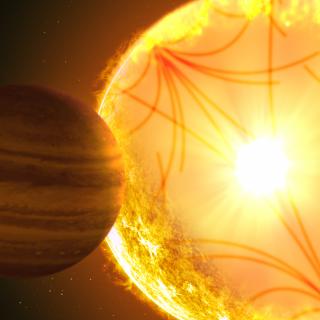Bibcode
Egger, J. A.; Osborn, H. P.; Kubyshkina, D.; Mordasini, C.; Alibert, Y.; Günther, M. N.; Lendl, M.; Brandeker, A.; Heitzmann, A.; Leleu, A.; Damasso, M.; Bonfanti, A.; Wilson, T. G.; Sousa, S. G.; Haldemann, J.; Delrez, L.; Hooton, M. J.; Zingales, T.; Luque, R.; Alonso, R.; Asquier, J.; Bárczy, T.; Navascues, D. Barrado; Barros, S. C. C.; Baumjohann, W.; Benz, W.; Billot, N.; Borsato, L.; Broeg, C.; Buder, M.; Castro-González, A.; Cameron, A. Collier; Correia, A. C. M.; Cortes, D.; Csizmadia, Sz.; Cubillos, P. E.; Davies, M. B.; Deleuil, M.; Deline, A.; Demangeon, O. D. S.; Demory, B. -O.; Derekas, A.; Edwards, B.; Ehrenreich, D.; Erikson, A.; Fortier, A.; Fossati, L.; Fridlund, M.; Gandolfi, D.; Gazeas, K.; Gillon, M.; Güdel, M.; Helling, Ch.; Isaak, K. G.; Kiss, L. L.; Korth, J.; Lam, K. W. F.; Laskar, J.; Lavie, B.; des Etangs, A. Lecavelier; Lovis, C.; Luntzer, A.; Magrin, D.; Maxted, P. F. L.; Merín, B.; Munari, M.; Nascimbeni, V.; Olofsson, G.; Ottensamer, R.; Pagano, I.; Pallé, E.; Peter, G.; Piazza, D.; Piotto, G.; Pollacco, D.; Queloz, D.; Ragazzoni, R.; Rando, N.; Rauer, H.; Ribas, I.; Rodrigues, J.; Santos, N. C.; Scandariato, G.; Ségransan, D.; Simon, A. E.; Smith, A. M. S.; Stalport, M.; Sulis, S.; Szabó, Gy. M.; Udry, S.; Van Grootel, V.; Venturini, J.; Villaver, E.; Walton, N. A.
Referencia bibliográfica
Astronomy and Astrophysics
Fecha de publicación:
8
2024
Revista
Número de citas
18
Número de citas referidas
17
Descripción
Multiplanetary systems spanning the radius valley are ideal testing grounds for exploring the different proposed explanations for the observed bimodality in the radius distribution of close-in exoplanets. One such system is HIP 29442 (TOI-469), an evolved K0V star hosting two super-Earths and one sub-Neptune. We observed HIP 29442 with CHEOPS for a total of 9.6 days, which we modelled jointly with two sectors of TESS data to derive planetary radii of 3.410 ± 0.046, 1.551 ± 0.045, and 1.538 ± 0.049 R⊕ for planets b, c, and d, which orbit HIP 29442 with periods of 13.6, 3.5, and 6.4 days, respectively. For planet d this value deviates by more than 3σ from the median value reported in the discovery paper, leading us to conclude that caution is required when using TESS photometry to determine the radii of small planets with low per-transit signal-to-noise ratios and large gaps between observations. Given the high precision of these new radii, combining them with published RVs from ESPRESSO and HIRES provides us with ideal conditions to investigate the internal structure and formation pathways of the planets in the system. We introduced the publicly available code plaNETic, a fast and robust neural network-based Bayesian internal structure modelling framework. We then applied hydrodynamic models to explore the upper atmospheric properties of these inferred structures. Finally, we identified planetary system analogues in a synthetic population generated with the Bern model for planet formation and evolution. Based on this analysis, we find that the planets likely formed on opposing sides of the water iceline from a protoplanetary disk with an intermediate solid mass. We finally report that the observed parameters of the HIP 29442 system are compatible with a scenario where the second peak in the bimodal radius distribution corresponds to sub-Neptunes with a pure H/He envelope and with a scenario with water-rich sub-Neptunes.
This article uses data from the CHEOPS Guaranteed Time Observation programme CH_PR100031. The raw and detrended photometric time-series data are available at the CDS via anonymous ftp to cdsarc.cds.unistra.fr (ftp://130.79.128.5) or via https://cdsarc.cds.unistra.fr/viz-bin/cat/J/A+A/688/A223
Proyectos relacionados

Sismología Solar y Estelar y Búsqueda de Exoplanetas
Los objetivos genéricos de este Proyecto son: 1) el estudio de la estructura y dinámica del interior solar, 2) la extensión de dicho estudio al caso de otras estrellas, 3) la búsqueda y caracterización de planetas extrasolares por métodos fotométricos (principalmente mediante el método de tránsitos) y espectroscópico (variaciones en la velocidad
Savita
Mathur

Exoplanetas y Astrobiología
La búsqueda de vida en el Universo se ha visto impulsada por los recientes descubrimientos de planetas alrededor de otras estrellas (los llamados exoplanetas), convirtiéndose en uno de los campos más activos dentro de la Astrofísica moderna. En los últimos años los descubrimientos cada vez más numerosos de nuevos exoplanetas y los últimos avances
Enric
Pallé Bago